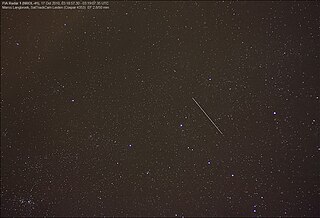
A reconnaissance satellite or intelligence satellite is an Earth observation satellite or communications satellite deployed for military or intelligence applications.

Imagery intelligence (IMINT), pronounced as either as Im-Int or I-Mint, is an intelligence gathering discipline wherein imagery is analyzed to identify information of intelligence value. Imagery used for defence intelligence purposes is generally collected via satellite imagery or aerial photography.

The Landsat program is the longest-running enterprise for acquisition of satellite imagery of Earth. It is a joint NASA / USGS program. On 23 July 1972, the Earth Resources Technology Satellite was launched. This was eventually renamed to Landsat 1 in 1975. The most recent, Landsat 8, was launched on 11 February 2013.

The Blue Marble is an image of Earth taken on December 7, 1972, from a distance of about 29,000 kilometers from the planet's surface. It was taken by the crew of the Apollo 17 spacecraft on its way to the Moon, and is one of the most reproduced images in history.

Landsat 7 is the seventh satellite of the Landsat program. Launched on 15 April 1999, Landsat 7's primary goal is to refresh the global archive of satellite photos, providing up-to-date and cloud-free images. The Landsat program is managed and operated by the United States Geological Survey, and data from Landsat 7 is collected and distributed by the USGS. The NASA WorldWind project allows 3D images from Landsat 7 and other sources to be freely navigated and viewed from any angle. The satellite's companion, Earth Observing-1, trailed by one minute and followed the same orbital characteristics, but in 2011 its fuel was depleted and EO-1's orbit began to degrade. Landsat 7 was built by Lockheed Martin Space Systems.

DigitalGlobe is an American commercial vendor of space imagery and geospatial content, and operator of civilian remote sensing spacecraft. The company went public on the New York Stock Exchange on 14 May 2009, selling 14.7 million shares at $19.00 each to raise $279 million in capital. On 5 October 2017, Maxar Technologies completed its acquisition of DigitalGlobe.

Satellite images are images of Earth collected by imaging satellites operated by governments and businesses around the world. Satellite imaging companies sell images by licensing them to governments and businesses such as Apple Maps and Google Maps. It should not be confused for astronomy images collected by space telescope.
IKONOS was a commercial Earth observation satellite, and was the first to collect publicly available high-resolution imagery at 1- and 4-meter resolution. It collected multispectral (MS) and panchromatic (PAN) imagery. The capability to observe Earth via space-based telescope has been called "one of the most significant developments in the history of the space age", and IKONOS brought imagery rivaling that of military spy satellites to the commercial market. IKONOS imagery began being sold on 1 January 2000, and the spacecraft was retired in 2015.
Lockheed Martin Space is one of the four major business divisions of Lockheed Martin. It has its headquarters in Denver, Colorado with additional sites in Sunnyvale, California; Santa Cruz, California; Huntsville, Alabama; and elsewhere in the United States and United Kingdom. The division currently employs about 16,000 people, and its most notable products are commercial and military satellites, space probes, missile defense systems, NASA's Orion spacecraft, and the Space Shuttle external tank.
GlobeXplorer was an online spatial data company that compiled and distributed aerial photos, satellite imagery, and map data from their online spatial archives. GlobeXplorer has been credited as the first company to establish a business around compiling and distributing online aerial and satellite imagery. In 2007, the company was acquired by DigitalGlobe.

Google Earth is a computer program, formerly known as Keyhole EarthViewer, that renders a 3D representation of Earth based primarily on satellite imagery. The program maps the Earth by superimposing satellite images, aerial photography, and GIS data onto a 3D globe, allowing users to see cities and landscapes from various angles. Users can explore the globe by entering addresses and coordinates, or by using a keyboard or mouse. The program can also be downloaded on a smartphone or tablet, using a touch screen or stylus to navigate. Users may use the program to add their own data using Keyhole Markup Language and upload them through various sources, such as forums or blogs. Google Earth is able to show various kinds of images overlaid on the surface of the earth and is also a Web Map Service client. Recently Google has revealed that Google Earth now covers more than 98 percent of the world, and has captured 10 million miles of Street View imagery, a distance that could circle the globe more than 400 times.

Raytheon Intelligence, Information and Services is a business unit of Raytheon Company headquartered in Dulles, Virginia. IIS specializes in intelligence, surveillance and reconnaissance; advanced cybersecurity solutions; weather and environmental solutions, and information-based solutions for homeland security. The company also provides training, logistics, engineering, product support, and operational support services and solutions for the mission support, homeland security, space, civil aviation, counter-proliferation and counter-terrorism markets. IIS employs approximately 17,000 people at 551 sites in 100+ countries worldwide. In 2018, the company recorded $6.7 billion in sales and $538 million in operating income. Dave Wajsgras is the President of IIS.
Raytheon Intelligence & Space (RIS) is one of the four business segments of U.S. defense and aerospace conglomerate Raytheon Technologies. Headquartered in Arlington, Virginia, RIS has a total employment of 39,000 and 2019 sales of US$15 billion. Roy Azevedo is the segment's President.

Future Imagery Architecture (FIA) was a program awarded to Boeing to design a new generation of optical and radar imaging US reconnaissance satellites for the National Reconnaissance Office (NRO). In 2005 NRO director Donald Kerr recommended the project's termination, and the optical component of the program was finally cancelled in September 2005 by Director of National Intelligence John Negroponte. FIA has been called by The New York Times "perhaps the most spectacular and expensive failure in the 50-year history of American spy satellite projects." Despite the optical component's cancellation, the radar component, known as Topaz, has continued, with four satellites in orbit as of February 2016.

GeoEye Inc. was an American commercial satellite imagery company based in Herndon, Virginia. GeoEye was merged into the DigitalGlobe corporation January 29, 2013.

RemoteView is the family name of a group of software programs designed by Textron Systems Geospatial Solutions to aid in analyzing satellite or aerial images of the Earth's surface for the purpose of collecting and disseminating geospatial intelligence. The National Geospatial-Intelligence Agency (NGA) was a user of RemoteView software.

Earth Observing-1 (EO-1) is a decommissioned NASA Earth observation satellite created to develop and validate a number of instrument and spacecraft bus breakthrough technologies. It was intended to enable the development of future Earth imaging observatories that will have a significant increase in performance while also having reduced cost and mass. The spacecraft was part of the New Millennium Program. It was the first satellite to map active lava flows from space; the first to measure a facility's methane leak from space; and the first to track re-growth in a partially logged Amazon forest from space. EO-1 captured scenes such as the ash after the World Trade Center attacks, the flooding in New Orleans after Hurricane Katrina, volcanic eruptions and a large methane leak in southern California.
SkySat is a constellation of sub-meter resolution Earth observation satellites owned by Planet Labs, providing imagery, high-definition video and analytics services. Planet acquired the satellites with their purchase of Terra Bella, a Mountain View, California-based company founded in 2009 by Dan Berkenstock, Julian Mann, John Fenwick, and Ching-Yu Hu, from Google in 2017.
Edge Development Option (EDO) comprises a set of C++ computer libraries produced by Boeing that allows to quickly build 2D and 3D visualization software similar to Google Earth, in order to display satellite imagery and create virtual scenarios for displaying sensor, 3D models, 4D (time-dependent) tracks and for line-of-sight and smart volume analysis. EDO is a toolkit based on EDGE Whole Earth, a software program developed by a company named Autometric, now part of Boeing. While EDGE was initially mainly developed for SGI machines, EDO is mainly Windows-based. EDO retained much of EDGE's functionality but allowed greater flexibility for developers, i.e. the ability to integrate EDO functionality into their own application leveraging on EDO's libraries. Google Earth is the more famous heir to the 3D applications EDGE and EDO.

Planet Labs, Inc. is an American private Earth imaging company based in San Francisco, California. Their goal is to image the entirety of the Earth daily to monitor changes and pinpoint trends.












